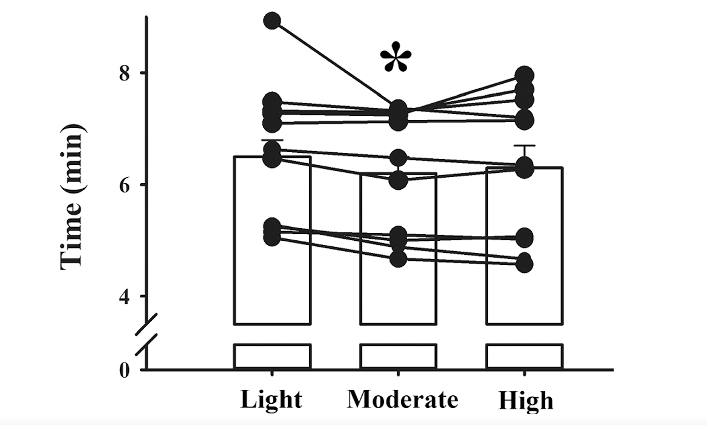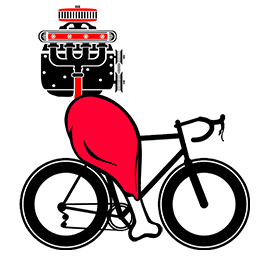Go With a Medium Warm Up, Not Easy or Hard
A new study published in the International Journal of Sports Science & Coaching found that warming up at a moderate intensity well before reporting to the start line led to the fastest 1600-meter time trial performance compared to lighter or more intense warm ups, even with a prolonged wait time of 20 minutes. This delay between warm up and starting a race occurs frequently because of the need to check-in and report to the starting line of a track event, running road race, triathlon, or cycling event. The study looked at 14 trained men and women with moderately high aerobic capacities (avg VO2 max of ~50)
While a 20-minute wait time between warming up and competing is not ideal, many endurance athletes face situations where they have to report to the start area well in advance. This study showed that a moderate-intensity warm up done earlier still provides benefits for performance, even with extended waiting periods.

The researchers tested three different warm up routines of light, moderate, and high intensity before having the runners rest for 20 minutes and then complete a 1600-meter time trial. A light warm up consisted of easy jogging and active stretching, while a moderate warm up involved briefly elevating the heart rate and a high-intensity warm up significantly spiked the heart rate.
The results showed significantly faster 1600-meter times following the moderate-intensity warm up done 20 minutes earlier. Performance after the high-intensity warm up fell between the light and moderate warm ups. The researchers measured blood lactate levels, a measure of intensity, before the time trials. They found performance was maximized when blood lactate levels were between 2 to 5 mmol/L prior to the run, which aligns with a moderate-intensity warm up.
In conclusion, endurance athletes seeking peak performance should aim for a moderate-intensity warm up well before having to report to the start line, even if facing longer wait times. A light warm up may not provide enough activation, while an intense warm up could potentially fatigue the body prior to performance. More research is still needed, but for now, a moderate warm up intensity seems ideal for endurance athletes to maximize performance whenever possible, even if less-than-ideal wait times exist. An earlier, properly-structured warm up can still enhance endurance performance.
Practical Implementation of this Study
According to this particular study’s results, the following warm protocols should be included. Note: We will post future studies on warm ups here.
Make sure your pre-race warm up includes some moderate efforts between LT1 and LT2. The corresponding MODERATE effort can be defined as follows:
| Intesity(remember moderate is recommended) | RPE (1-10) | % of max Heart Rate | % of 60 min power (watts) |
| Low-Intensity Warm Up (<LT1) | 3 or less | 75% or less | 80% or less |
| Moderate-Intensity Warm Up (LT1-LT2) | 4-6 | 76%-90% *stay on lower side for WU | 81-92% *stay on lower side for WU |
| High-Intensity Warm Up (>LT2) | 7-10 | 91% or more | 93% or more |
More about Lactate Threshold Lactate threshold one (LT1) or LOW intenstity: The exercise intensity at which lactate begins to accumulate in the bloodstream. This is an aerobic threshold and occurs at lower exercise intensities. At LT1, the body can still clear lactate from the blood effectively. Lactate threshold two (LT2) or HIGH intensity: The exercise intensity at which lactate accumulates rapidly in the bloodstream due to an imbalance between lactate production and removal. This is also called anaerobic threshold. At LT2, lactate cannot be cleared from the blood as quickly as it is produced, leading to a spike in blood lactate levels. LT2 is a marker of higher-intensity exercise that can be sustained for a limited time.
Again, the numbers above are very loose estimates of the low, mid, and high zones, not true measures of the individual athlete’s actual LT1 and LT2. But they are likely close enough for warm up purposes.
Abstract
Warm up intensity influences running performance despite prolonged recovery
When competing in road races, runners enter starting corrals long before the starting gun triggers. Athletes consequently must complete warm up routines well in advance of race commencement. To optimize performance readiness warm up intensity may need altered to account for the prolonged time between warm up and performance. This study tested the effectiveness of various warm up intensities on 1600 m run performance given a 20 min separation between warm up and time trial, and assessed the physiological bases for performance outcomes. In a randomized, crossover design, 14 athletic men and women [(age (mean ± SEM) = 22 ± 1 y; V·O2peak = 50.3 ± 2.5 ml·kg−1·min−1] completed three warm up routines (light-, moderate-, or high-intensity warm up), rested for 20 min, and ran a 1600 m time trial. Warm up procedures were evaluated for their influence on performance, blood lactate, V·O2, and alterations to neuromuscular function. Time trial performance was significantly faster (P < 0.03) following a moderate-intensity warm up (6:12 ± 18 min:s·1600 m−1) compared to a light-intensity warm up (6:30 ± 18 min:s·1600 m−1). Performance following the high-intensity warm up (6:18 ± 24 min:s·1600 m−1) fell between the light and moderate conditions. When stratified based on starting lactate concentrations, 1600 m performance was optimized when pre-time trial lactate was 2.0–4.9 mmol·l−1. When a prolonged rest separates warm up exercise from time trial performance, warming up remains efficacious. Optimal warm up intensity may be identified using starting lactate as a gauge for performance readiness.
Published in International Journal of Sports Science & Coaching, 2021
Full text
Authors: Hunter L Paris, E. Sinai, M. Leist, Carrington M Crain, Alexandra M. Keller, William Malysa, Shelby C Renzullo
Listen to the Two Minute Study Summary

Jordan Fowler has experience as a head swimming coach of the Frisco Swim Team, a TAAF-awarded coach, a track and field distance running consultant for select Texas High School runners, and has competed as a triathlete, road runner, and cyclist. Though he is remarkably slower than he was in his 20s and 30s, he still enjoys endurance sports and sports science studies.
